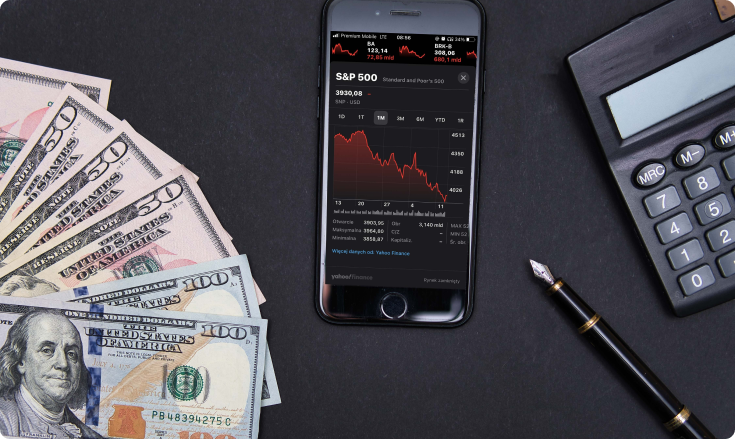How To Trade CFDs?

The “Contract for Difference” (CFD) represents a special financial instrument derived from an asset, that gives the trader an opportunity to profit from changes in the prices, while not owning the underlying asset itself. Rather than settling the underlying asset, you are trading on the price movement of the underlying asset. CFD trading can apply to various products, such as currency pairs, indices, commodities, single stocks, and cryptocurrencies. A key feature of CFDs is that they allow you to trade on markets that are heading downwards, in addition to those that are heading up—allowing them to deliver profit even when the market is in turmoil.
Why were CFDs created?
CFDs were initially used by hedge fund managers and institutional traders as they provided a cost-effective hedge when trading stocks on the stock exchange.
The main benefit derived from the CFD trading format is it requires only a small margin for trade. No physical shares change hands which also means no stamp duty is required on CFD trade deals.
What is CFD stock trading?
CFD stocks trading entails trading on stock prices of publicly traded companies. Some of the popular stocks you might’ve heard of are Tesla (TSLA), Apple (AAPL), Alibaba (BABA), Amazon (AMZN), Microsoft (MSFT), etc. Those are just some of the most popular companies that are publicly traded, but you can find many more that you could trade with and potentially profit from the price movements of their stocks.
Whenever you buy a stock price, someone is selling that stock price to you. Likewise, when you’re looking to sell your stock price, someone else will be buying it from you. The market is huge and many people are interested in buying or selling any given stock price at any time.
The price of the stock depends on many factors and one of the most important ones is the number of buyers and sellers in the market. If more people are interested in buying the stock compared to the number of people wanting to sell it, the stock price will go up as the demand is higher. If people are more interested in selling the stock that will push the price downwards.
What are CFD currency pairs?
If you are looking to trade Forex CFDs, then you need to understand the foreign exchange market. CFDs simply represent an alternative means of trading on forex currency pairs. A Forex quote consists of two currencies; the base currency and the quote currency. The currency pair can be a reflection of the strength of one economy versus another, and the exchange rate is a function of the relationship of the two economies. You should try to understand and consider the various technical, political, and economic events that have the greatest effect on each currency. The Euro to US Dollar currency pair is the single most widely-traded Forex pair on the market.
Other major currency pairs are USD/JPY, GBP/USD, USD/CAD, and AUD/USD.
It is important to understand how Forex pairs are quoted because when you have a firm grasp of the fundamentals of a particular currency pair, you can then investigate how CFDs work. Traditional Forex trading and Forex CFDs trading are not the same things. On one hand, the basis of Forex trading is the exchange of a certain amount of one currency against another. For instance, if you were to purchase GBP/USD, you would profit if the pound appreciated against the US dollar (GBP/USD moves higher) or lose money if the exchange rate falls (GBP/USD moves lower).
On the other hand, CFD trading allows you to place leveraged trades on currency pairs, speculating on the movement of the underlying instrument. Rather than settling (or delivering) a set amount of base currency, CFDs are cash-settled, based on the difference between the opening and closing prices of a pair of currencies. One of the key features of CFD trading is that by using leverage you can increase your trade size while committing a relatively small amount of capital. You should keep in mind that while increasing your exposure magnifies potential profits, it also magnifies potential losses.
What is CFD crypto trading?
Cryptocurrencies have also begun to generate a lot of interest as an alternative investment or CFDs.
A large part of this is down to headlines generated by the huge leaps in Bitcoin’s value, as the price of it was worth around $1,000 in 2017, rocketing to more than $19,000 by December of that year. In November 2021 it reached all-time highs of around $69,000. Bitcoin prices are now down nearly 70% hovering around $20,000 worth of value. When prices move quickly, traders pay attention.
Many people gain exposure to cryptocurrencies by simply putting money into them – that is, buying the actual digital currency. There are downsides to this, however. Processing times for buying a cryptocurrency are slower than the instant fills that characterize a Forex trade. They are unregulated and there have been alarming stories of compromised Bitcoin and Ethereum wallets.
You can easily sidestep all these concerns by trading cryptocurrencies via CFDs. Using CFDs allows for very fast transaction times, which is useful in such a volatile market. Some of the most traded cryptocurrencies include Bitcoin, Ethereum, Tether, USD Coin, etc.
What is CFD commodities trading?
The commodity market is one of the oldest financial markets. Today, traders have the option of trading commodities via CFDs. CFDs are considered an efficient way to trade popular commodities - such as oil, gas, gold, or silver - due to higher leverage. This enables a trader to use less capital while gaining greater exposure to an underlying instrument, increasing the potential for losses as well as profits. CFDs allow traders to speculate on the price movements of the underlying instrument without taking actual ownership of the product itself. CFDs also allow you to trade on margin. This means you are only required to deposit a percentage of the total value of a trade. In other words, you have the option to allocate significantly less capital when trading in CFDs as opposed to futures contracts.
What is CFD indices trading?
CFDs allow you to trade on indices without purchasing the underlying asset. Some of the popular indices you might’ve heard of are S&P 500, Nasdaq 100, DJIA, FTSE, etc. This quick way of gaining exposure to the underlying asset is just one of the benefits of the CFD trade. Index CFDs offer traders an alternative instrument to individual stocks. Moving alongside the gains and losses of multiple companies, fluctuations in indices are typically less drastic and move in line with consumer confidence or major market events. This is in contrast to individual stocks which may see volatility as a result of a failed product launch, PR problems, poor sales, or various other factors.
How to trade CFDs?
CFDs allow traders to take a position on whether the value of a financial market - for example, a share, commodity, currency pair, or stock index - will rise or fall in the short, medium, or long term.
If a trader believes that the price of a market is going to rise, they will usually buy or ‘go long’’ and profit from every increase in price. If a trader believes that the price of an asset is going to fall, they will usually sell or ‘go short" and profit from every fall in price. If prices move against them, however, they will suffer a loss.
With CFDs, traders don’t own the underlying asset - they are simply speculating on the movement of its price. Therefore there are no physical dealing costs, such as the UK Stamp Duty.
CFDs are a leveraged product, meaning traders are only required to deposit a small initial deposit in order to gain much larger market exposure.
Steps to your first CFD trade with Limit Prime
Here are the basic steps on how to enter a CFD trade and how to close it:
- Click Open a real account.
- Complete registration.
- Deposit the amount of money you would like to trade with.
- Choose a financial instrument you will trade with.
- When you log in to your account on the platform, you will see a number of financial instruments you can trade with. For now, choose just one of them (eg. EUR/ USD).
- Choose to buy or sell.
- After you analyze the market, you can decide whether to buy or sell this asset. If you think a price will rise, you should buy, and vice versa - if you think a price will decrease, you should sell.
- Enter a trade size.
- This is where you choose a lot size for your trade. 1 CFD is the equivalent of 1 physical share in equity trades.
- Manage your risk.
Choosing to set a “pending order” will protect you from going deep in losses, and will close your trading position at a certain price. Whereas instant execution opens a transaction at the price currently quoted on the market, pending orders allow you to set orders that will be activated once the price reaches a level chosen by you. - Monitor your position.
When you are just starting out, we advise you to monitor your position. Even if you set any “pending orders” or “take profit orders”, monitoring will help you to see your real-time profit/ loss. You can track market prices, see your profit/ loss update in real-time and add new trades or close existing trades. - Close the position.
In case your position is not automatically closed because you didn’t set any pending order or take-profit order, you can close your position whenever you are ready.
Example of CFDs trading
For a better understanding of how it all works, watch the video below.
Conclusion
With CFD trading, you don’t buy or sell an asset itself - you don’t possess it physically.
The number one benefit of trading with CFDs is that you only need to deposit a small percentage (margin amount) of the full value of the trade, in order to open a position with a broker.
Trading CFDs includes leverage. Leverage is a means to help you profit more but can make you lose more, sometimes even more than your initial deposit (depending on the broker - you may or may not be protected from negative balance).
Check out our example above which can help you understand the CFDs trading process, and how you can benefit from it, or click here to learn more.
Sources Consulted
1. What are CFDs? 17 Mar 2021 [cited 23 Mar 2021]. Available: https://www.cmcmarkets.com/en/learn-cfd-trading/what-are-cfds
2. CFD Examples. 17 Mar 2021 [cited 23 Mar 2021]. Available: https://www.cmcmarkets.com/en/learn-cfd-trading/cfd-examples
3. What is CFD trading and how does it work? [cited 23 Mar 2021]. Available: https://www.ig.com/en/cfd-trading/what-is-cfd-trading-how-does-it-work
4. What is a Lot in Forex? BabyPips.com; 4 Dec 2011 [cited 23 Mar 2021]. Available: https://www.babypips.com/learn/forex/lots-leverage-and-profit-and-loss
5. Picardo E. Understanding bid-ask spreads when exchanging foreign currency. 29 Aug 2020 [cited 23 Mar 2021]. Available: https://www.investopedia.com/articles/forex/090914/understanding-spread-retail-currency-exchange-rates.asp
6. Lee M. What is a pip? 15 Oct 2020 [cited 23 Mar 2021]. Available: https://www.investopedia.com/ask/answers/06/pipexplained.asp
LimitPrime © 2025
Begin to invest and
start earning today!
Categories
Do you need personalized assistance?
READ MORE INTERESTING ARTICLES

Diversificationnoun the action of diversifying something or the fact of becoming more diverse. a trading strategy that reduces risk. D...
Read More
As any risk disclosure will tell you, trading financial instruments put the trader at risk of losing some or all of their allocated cap...
Read More
What are indices?Indices measure the performance of a group of stocks, bonds or other investments. These investments are often grouped...
Read More